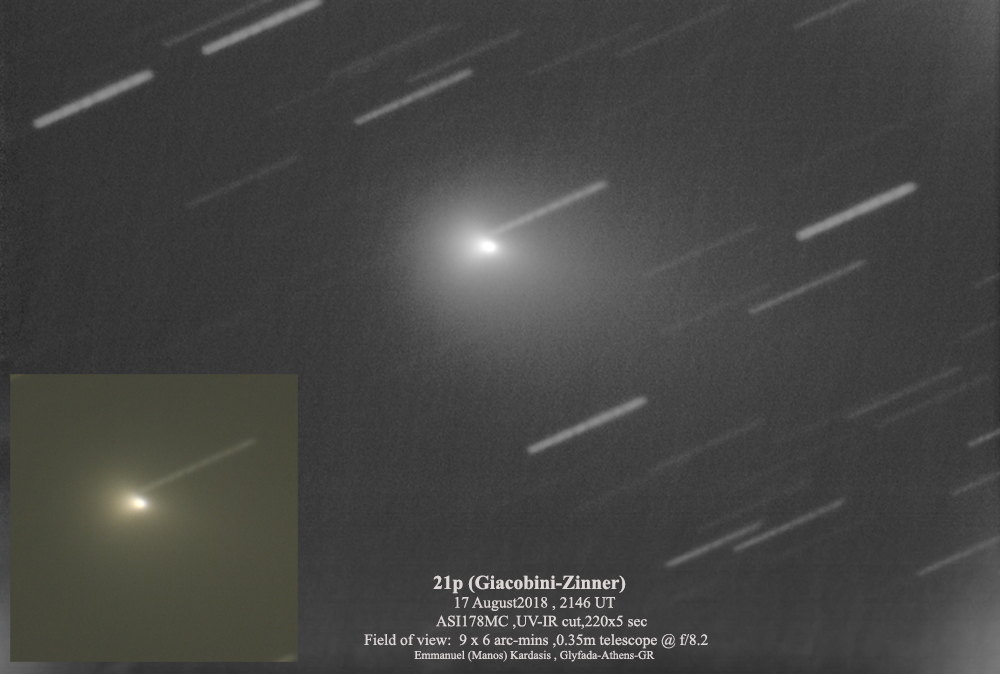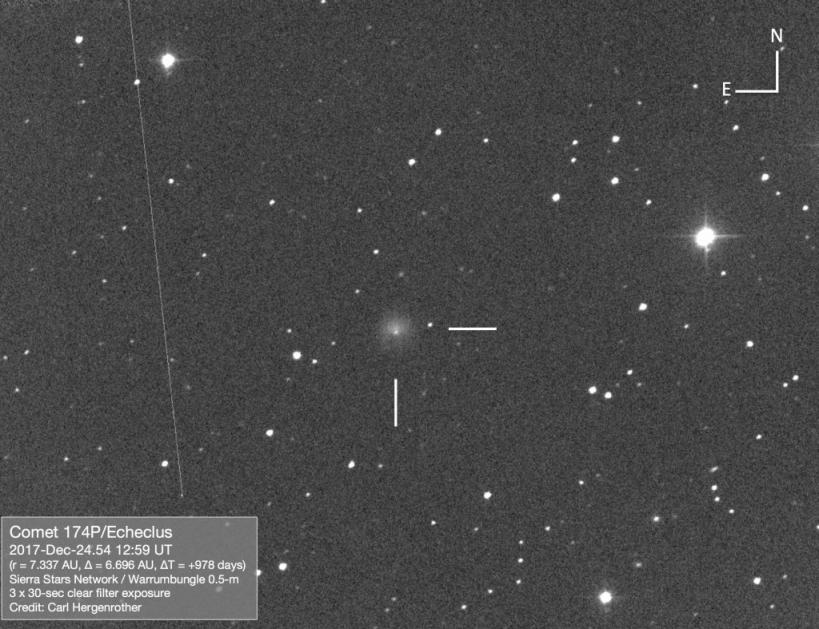ALPO COMET NEWS FOR OCTOBER 2018
2018-OCTOBER-5
This month will up to four comets as bright or brighter than 10th magnitude. 21P/Giacobini-Zinner will fade from 7th to 9th magnitude as it rapidly moves south. As 21P fades, the next bright comet, 46P/Wirtanen, quickly brightens to take its place. In addition to 46P, comets 38P/Stephan-Oterma and 64P/Swift-Gehrels brighten to near or slightly brighter than magnitude 10.0.
Bright Comets (magnitude < 10)
21P/Giacobini-Zinner – Short-period comet 21P/Giacobini-Zinner starts the month as the brightest comet at magnitude ~7.7. Now a few weeks past perihelion and its closest approach to Earth, 21P will be fading this month and should hand its ‘brightest comet’ title to 46P/Wirtanen towards the end of the month.
G-Z has provided observers with a number of memorable views as it traveled through the star, cluster and nebula-rich winter Milky Way. October will be no different as it moves southwards through Monoceros (Oct 1-9) and Canis Major (9-31). Close approaches to the following deep sky objects occur this month: open clusters NGC 2311 (Oct 3), M50 (Oct 6/7), NGC 2335 (Oct 8), Cr 465 (Oct 8/9), NGC 2343 (Oct 8/9), NGC 2345 (Oct 11), NGC 2360 (Oct 14). CCD images have shown a nice long dust tail. Observers are encouraged to watch the evolution of 21P’s dust tail as we pass through orbit plane crossing on October 9th.
Visual observations submitted to the ALPO over the last week or so show 21P to be between magnitude 7.4 and 7.6. This suggests the comet is running a little fainter than expected. Then again the Moon had been bright and/or nearby and possibly hid the outer extent of 21P’s coma resulting in fainter estimates.
21P/Giacobini-Zinner T = 2018-Sep-10 q = 1.01 AU Short-Period comet Period = 6.5 yr Date Mag R.A. Decl. r d Elong const 2018-10-01 7.6 06 51 +00 03 1.055 0.453 84 Mon 2018-10-11 8.2 07 08 -11 42 1.103 0.515 87 CMa 2018-10-21 8.8 07 19 -20 41 1.165 0.583 91 CMa 2018-10-31 9.5 07 24 -27 33 1.237 0.653 95 CMa
38P/Stephan-Oterma – Comet Stephan-Oterma has an orbital period of ~38 years and is returning for the first time since 1980. This comet has a bit of an interesting backstory. In 1867, it was first sighted by Jérôme E. Coggia (Marseilles, France) who thought he had found an uncatalogued nebula. Over the following nights, followup observations by E. J. M. Stephan (Marseilles, France) uncovered the true nature of the object. For some reason, the discovery announcement cited Stephan as the discoverer with no mention of Coggia. After being missed at its next return in 1904, the comet was photographically rediscovered in 1942 by Liisi Oterma (Turku, Finland).
This month, 38P will be a morning object in Orion and Gemini as it brightens from 11th to just brighter than 10th magnitude. Ultimately the comet will peak around magnitude 9.0 to 9.5 in late November after its perihelion on November 10 at 1.59 AU. In 1980, Stephan-Oterma approached to within 0.59 AU of Earth and brightened to between magnitude 8.5 and 9.0. This year’s return will be a little further away at 0.76 AU, hence the slightly fainter maximum brightness.
38P/Stephan-Oterma T = 2018-Nov-10 q = 1.59 AU Short-Period comet Period = 38.0 yr Date Mag R.A. Decl. r d Elong const 2018-10-01 10.8 05 55 +11 56 1.670 1.199 98 Ori 2018-10-11 10.4 06 20 +13 47 1.636 1.102 102 Ori 2018-10-21 10.0 06 44 +15 54 1.610 1.016 106 Gem 2018-10-31 9.7 07 08 +18 21 1.594 0.941 111 Gem
46P/Wirtanen – The brightest comet of the year should be 46P/Wirtanen which will pass within 0.08 AU of the Earth in mid-December. Wirtanen will be located around a southern declination of -30 degrees till late November (in the constellations of Cetus and Fornax). The comet will rapidly brighten from 11th to 8th magnitude this month. The comet will become better placed for northern observers starting in late November as it rapidly moves north. Assuming it behaves as it has in the past, Wirtanen should peak around magnitude 3 in mid-December. Note, that as a short-period comet, Wirtanen is likely to be a large diffuse object around the time of closest approach. It is possible its coma diameter will be in excess of 1 degree. Do not expect it to appear as bright as a 3rd magnitude star since it light will be spread over a large area. Observers may need a relatively dark sky to see Wirtanen with the naked eye.
46P/Wirtanen
T = 2018-Dec-12 q = 1.06 AU Short-Period comet Period = 5.4 yr
Date Mag R.A. Decl. r d Elong const
2018-10-01 11.3 01 53 -26 14 1.418 0.479 144 For
2018-10-11 10.3 01 56 -29 09 1.340 0.404 141 For
2018-10-21 9.2 01 57 -31 35 1.267 0.339 137 For
2018-10-31 8.1 01 59 -32 59 1.201 0.280 132 For
Faint Comets (between magnitude 10 and 13)
64P/Swift-Gehrels – Comet Swift-Gehrels was originally discovered visually by Lewis Swift (Rochester, New York) in 1889. Swift was also the discoverer of the Perseid parent body, Swift-Tuttle. After the 1889 apparition Swift’s comet went unobserverd until 1973 when its was rediscovered by Tom Gehrels on photographic plates taken at Palomar Observatory in southern California. 2018 marks Swift-Gehrels’ 7th observed return. Since its discovery in 1889, the comet’s orbit has been fairly stable with an orbital period of 9.4 years and perihelion distance near its current value of 1.39 AU. Not an especially bright object, this year’s return will be its best known return with a minimum Earth-comet distance of 0.44 AU on October 28. You will have to wait till 2092 for another return as good as this year’s though the 2046 return will just a little worse.
64P has already shown some excitement with a short lived outburst that saw it brighten by ~2-3 magnitudes to around 13th magnitude in mid-August. Swift-Gehrels has since settled down again and, unless it outbursts again, should brighten from 15th to 12th magnitude this month. Peak brightness will be around magnitude 9.5 in late November.
The magnitudes given below are based on 64P’s behavior during its 1981 apparition. Even considering its mid-August outburst, 64P seems to be running brighter than predicted. Observations submitted to COBS over the past few days show the comet to be between magnitude 10.1 and 11.4.
64P/Swift-Gehrels
T = 2018-Nov-03 q = 1.39 AU Short-Period comet Period = 8.9 yr
Date Mag R.A. Decl. r d Elong const
2018-10-01 12.2 00 28 +31 27 1.452 0.491 151 And
2018-10-11 11.4 00 32 +34 10 1.423 0.463 151 And
2018-10-21 10.7 00 37 +35 59 1.403 0.448 150 And
2018-10-31 10.1 00 46 +36 51 1.394 0.445 149 And
C/2016 M1 (PANSTARRS) – Visual observations by Chris Wyatt on October 1 found the comet at magnitude 10.2. Having passed perihelion on August 10 at 2.21 AU and now moving away from both the Earth and Sun, C/2016 M1 should continue to slowly fade as it moves through the southern constellations of Centaurus and Circinus.
C/2016 M1 (PANSTARRS) T = 2018-Aug-10 q = 2.21 AU Long-Period comet - dynamically old Date Mag R.A. Decl. r d Elong const 2018-10-01 10.1 14 27 -61 51 2.290 2.564 62 Cen 2018-10-11 10.3 14 32 -63 37 2.322 2.673 58 Cen 2018-10-21 10.5 14 39 -65 40 2.360 2.766 56 Cir 2018-10-31 10.7 14 49 -68 01 2.402 2.842 54 Cir
C/2016 R2 (PANSTARRS) - CO+ rich comet C/2016 R2 (PANSTARRS) continues its very slow fade. Thanks to its large perihelion distance (2.60 AU), the comet experiences slow changes in its heliocentric and geocentric distances. The comet should remain around 12th magnitude this month as it pulls away from the Sun in the northern morning sky.
C/2016 R2 (PANSTARRS) T = 2018-May-02 q = 2.60 AU Long-Period comet - dynamically old Date Mag R.A. Decl. r d Elong const 2018-09-01 11.7 10 58 +50 43 2.869 3.532 42M UMa 2018-09-11 11.8 11 27 +49 40 2.914 3.538 44M UMa 2018-09-21 11.9 11 56 +48 29 2.962 3.544 47M UMa 2018-10-01 12.0 12 23 +47 14 3.012 3.552 50M CVn
Other Comets of Interest
(944) Hidalgo and (3552) Don Quixote – Two bright low activity or dormant comets come to perihelion this year. (3552) Don Quixote is still designated an asteroid even though a tail was seen in 2009 with the Spitzer IR space telescope and again this March at visible wavelengths with a 4.1-m telescope. This month Don Quixote is near magnitude 16.3. (944) Hidalgo is still inbound and will peak in brightness at 14.3 in November. Unlike Don Quixote, Hidalgo has shown no cometary activity so far.
364P/PANSTARRS – 364P/PANSTARRS is a low activity comet that only shows activity at small heliocentric distances. Discovered in 2013, 364P is making its second observed return with perihelion having occurred in late June at 0.80 AU. Cometary activity has now ceased though a residual dust tail is still visible. This month CCD observers will be able to image the bare nucleus of 364P as it fades from magnitude 17.7 to 19.3.
364P/PANSTARRS T = 2018-Jun-24 q = 0.80 AU Short-Period comet Period = 4.9 yr Date Mag R.A. Decl. r d Elong const 2018-10-01 17.6 00 02 -23 18 1.625 0.668 153 Cet 2018-10-11 18.1 23 49 -20 18 1.728 0.801 147 Aqr 2018-10-21 18.7 23 42 -17 32 1.828 0.953 139 Aqr 2018-10-31 19.3 23 40 -15 01 1.927 1.122 131 Aqr
(944) Hidalgo T = 2018-Oct-26 q = 1.95 AU Extinct comet Period = 13.8 yr Date Mag R.A. Decl. r d Elong const 2018-10-01 14.6 06 18 +58 31 1.964 1.625 93 Lyn 2018-10-11 14.5 06 55 +63 01 1.954 1.561 97 Cam 2018-10-21 14.4 07 38 +67 09 1.948 1.512 99 Cam 2018-10-31 14.4 08 30 +70 40 1.948 1.478 102 UMa
(3552) Don Quixote T = 2018-May-07 q = 1.24 AU Extinct comet Period = 8.8 yr Date Mag R.A. Decl. r d Elong const 2018-10-01 16.3 02 34 +52 15 2.134 1.405 124 Per 2018-10-11 16.3 02 14 +53 58 2.218 1.433 130 Per 2018-10-21 16.4 01 52 +54 37 2.301 1.480 135 Per 2018-10-31 16.5 01 31 +54 18 2.384 1.548 138 Per
As always, the Comet Section is happy to receive all comet observations, whether images, drawings, magnitude estimates, and even spectra. Please send your observations via email to < carl.hergenrother @ alpo-astronomy.org >. - Carl Hergenrother (ALPO Comet Section Coordinator)













